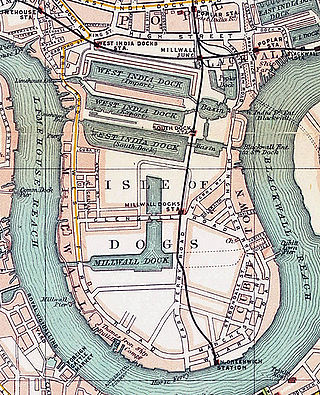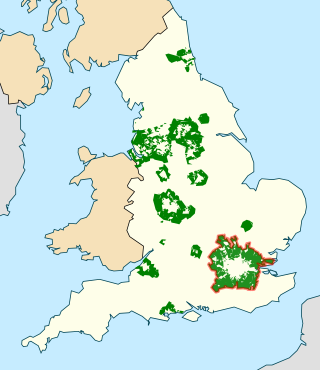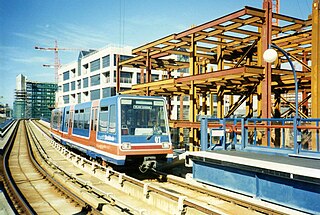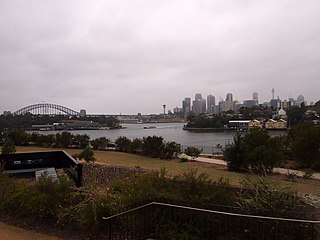
London Docklands is the riverfront and former docks in London. It is located in inner east and southeast London, in the boroughs of Southwark, Tower Hamlets, Lewisham, Newham and Greenwich. The docks were formerly part of the Port of London, at one time the world's largest port. After the docks closed, the area had become derelict and poverty-ridden by the 1980s. The Docklands' regeneration began later that decade; it has been redeveloped principally for commercial and residential use. The name "London Docklands" was used for the first time in a government report on redevelopment plans in 1971 and has since been almost universally adopted. The redevelopment created wealth, but also led to some conflict between the new and old communities in the area.

The Greater London Authority (GLA), colloquially known by the metonym City Hall, is the devolved regional governance body of Greater London, England. It consists of two political branches: an executive Mayor and the 25-member London Assembly, which serves as a means of checks and balances on the Mayor. Since May 2016, both branches have been under the control of the London Labour Party. The authority was established in 2000, following a local referendum, and derives most of its powers from the Greater London Authority Act 1999 and the Greater London Authority Act 2007.

Canberra is the capital city of Australia. Founded following the federation of the colonies of Australia as the seat of government for the new nation, it is Australia's largest inland city and the eighth-largest Australian city overall. The city is located at the northern end of the Australian Capital Territory at the northern tip of the Australian Alps, the country's highest mountain range. As of June 2022, Canberra's estimated population was 456,692.

In British town planning, the green belt is a policy for controlling urban growth. The term, coined by Octavia Hill in 1875, refers to a ring of countryside where urbanisation will be resisted for the foreseeable future, maintaining an area where local food growing, forestry and outdoor leisure can be expected to prevail. The fundamental aim of green belt policy is to prevent urban sprawl by keeping land permanently green, and consequently the most important attribute of green belts is their openness.

Thames Gateway is a term applied to an area around the Thames Estuary in the context of discourse around regeneration and further urbanisation. The term was first coined by the UK government and applies to an area of land stretching 70 kilometres (43 mi) east from inner east and south-east London on both sides of the River Thames and the Thames Estuary. It stretches from Westferry in Tower Hamlets to the Isle of Sheppey/Southend-on-Sea and extends across three ceremonial counties.

Cardiff Bay Barrage lies across the mouth of Cardiff Bay, Wales between Queen Alexandra Dock and Penarth Head. It was one of the largest civil engineering projects in Europe during construction in the 1990s.

The London Docklands Development Corporation (LDDC) was a quango agency set up by the UK Government in 1981 to regenerate the depressed Docklands area of east London. During its seventeen-year existence, it was responsible for regenerating an area of 8.5 square miles (22 km2) in the London Boroughs of Newham, Tower Hamlets and Southwark. LDDC helped to create Canary Wharf, Surrey Quays shopping centre, London City Airport, ExCeL Exhibition Centre, London Arena and the Docklands Light Railway, bringing more than 120,000 new jobs to the Docklands and making the area highly sought after for housing. Although initially fiercely resisted by local councils and residents, today it is generally regarded as having been a success and is now used as an example of large-scale regeneration, although tensions between older and more recent residents remain.
Kelo v. City of New London, 545 U.S. 469 (2005), was a landmark decision by the Supreme Court of the United States in which the Court held, 5–4, that the use of eminent domain to transfer land from one private owner to another private owner to further economic development does not violate the Takings Clause of the Fifth Amendment. In the case, plaintiff Susette Kelo sued the city of New London, Connecticut, for violating her civil rights after the city tried to acquire her house's property through eminent domain so that the land could be used as part of a "comprehensive redevelopment plan". Justice John Paul Stevens wrote for the five-justice majority that the city's use of eminent domain was permissible under the Takings Clause, because the general benefits the community would enjoy from economic growth qualified as "public use".

The Great Bear Rainforest is a temperate rain forest on the Pacific coast of British Columbia, comprising 6.4 million hectares. It is part of the larger Pacific temperate rainforest ecoregion, which is the largest coastal temperate rainforest in the world.

Ballast Point is a 2.6-hectare (6-acre) urban park located in Birchgrove at the tip of the Balmain Peninsula in the Inner West Council local government area in Sydney, New South Wales, Australia. The park is located adjacent to the point of the same name, situated between Snails Bay and Mort Bay in Sydney Harbour.
The New Towns Acts were a series of Acts of the Parliament of the United Kingdom to found new settlements or to expand substantially existing ones, to establish Development Corporations to deliver them, and to create a Commission to wind up the Corporations and take over their assets and liabilities. Of these, the more substantive acts were the New Towns Act 1946 and the Town Development Act 1952. "The New Towns Act [1946] was intended to pre-emptively direct urban growth and infrastructural development into new towns, thereby decentralising population and economic opportunity while inhibiting urban sprawl."

Cullacabardee is a northeastern rural suburb of Perth, the capital city of Western Australia, located 21 km (13 mi) from Perth's central business district via Alexander Drive or Beechboro Road. It is in the City of Swan local government area. Most of the suburb is covered in native sheoak and banksia forest. A small Noongar community is based on Baal Street, a drug rehabilitation retreat is located off Gnangara Road in the suburb's northeast, and the Perth International Telecommunications Centre facility is based in the suburb's northwest.

The Plymouth Development Corporation was an urban development corporation established in Plymouth, Devon, England by the UK Government on 1 April 1993 to "secure the physical, environmental, economic and social regeneration" of surplus parts of the Ministry of Defence's estate and some adjoining land. It had an indicative budget of £45 million and a lifetime of five years. Although subject to criticism for financial irregularities, it laid the foundation for improvements that continued for several years after it was wound up.
A ghost estate is an unoccupied housing estate, particularly one built in the Republic of Ireland during the period of economic growth when the Irish economy was known as the Celtic Tiger. A massive surplus of housing, combined with the late-2000s recession, resulted in a large number of estates being abandoned, unoccupied or uncompleted. The National Institute for Regional and Spatial Analysis defines a ghost estate as developments of "ten or more houses where 50% of the properties are either vacant or under-construction", which therefore does not fully cover the total number of unfinished estates.

In England and Wales, squatting—taking possession of land or an empty house the squatter does not own—occurs for a variety of reasons which include needing a home, protest, poverty, and recreation. Many squats are residential; some are also opened as social centres. Land may be occupied by New Age travellers or treesitters.

Bradford Crossrail is an idea to link together Bradford's two railway stations, Bradford Forster Square and Bradford Interchange. Both these stations are truncated versions of former station sites, Bradford Forster Square station and Bradford Exchange. These stations were built in the nineteenth century by different railway companies with an individual, rather than a comprehensive plan for rail development in the city.
Compulsory purchase is the power to purchase rights over an estate in English land law, or to buy that estate outright, without the current owner's consent. In England and Wales, Parliament has granted several different kinds of compulsory purchase power, which are exercisable by various bodies in various situations. Such powers are meant to be used "for the public benefit". This expression is interpreted broadly.
Low-impact development (LID) has been defined as "development which through its low negative environmental impact either enhances or does not significantly diminish environmental quality".

Squatting in Australia usually refers to a person who is not the owner, taking possession of land or an empty house. In 19th century Australian history, a squatter was a settler who occupied a large tract of Aboriginal land in order to graze livestock. At first this was done illegally, later under licence from the Crown.














